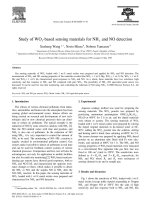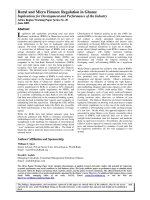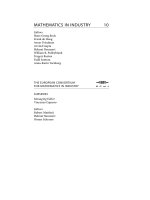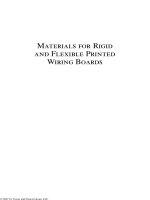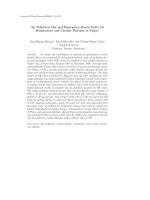Materials for Rigid and Flexible Printed Wiring Boards ppt
Bạn đang xem bản rút gọn của tài liệu. Xem và tải ngay bản đầy đủ của tài liệu tại đây (4.4 MB, 164 trang )
Materials for Rigid
and Flexible Printed
Wiring Boards
DK3212_C000.fm Page i Friday, August 11, 2006 11:24 AM
© 2007 by Taylor and Francis Group, LLC
ELECTRICALAND COMPUTER ENGINEERING
A Series of Reference Books and Textbooks
FOUNDING EDITOR
Marlin O. Thurston
Department of Electrical Engineering
The Ohio State University
Columbus, Ohio
1. Rational Fault Analysis,
edited by Richard Saeks
and S. R. Liberty
2. Nonparametric Methods in Communications,
edited by
P. Papantoni-Kazakos and Dimitri Kazakos
3. Interactive Pattern Recognition,
Yi-tzuu Chien
4. Solid-State Electronics,
Lawrence E. Murr
5. Electronic, Magnetic, and Thermal Properties of Solid
Materials,
Klaus Schröder
6. Magnetic-Bubble Memory Technology,
Hsu Chang
7. Transformer and Inductor Design Handbook,
Colonel Wm. T. McLyman
8. Electromagnetics: Classical and Modern Theory
and Applications,
Samuel Seely and Alexander D. Poularikas
9. One-Dimensional Digital Signal Processing,
Chi-Tsong Chen
10. Interconnected Dynamical Systems,
Raymond A. DeCarlo
and Richard Saeks
11. Modern Digital Control Systems,
Raymond G. Jacquot
12. Hybrid Circuit Design and Manufacture,
Roydn D. Jones
13. Magnetic Core Selection for Transformers and Inductors:
A User’s Guide to Practice and Specification,
Colonel Wm. T. McLyman
14. Static and Rotating Electromagnetic Devices,
Richard H. Engelmann
15. Energy-Efficient Electric Motors: Selection and Application,
John C. Andreas
16. Electromagnetic Compossibility,
Heinz M. Schlicke
17. Electronics: Models, Analysis, and Systems,
James G. Gottling
18. Digital Filter Design Handbook,
Fred J. Taylor
19. Multivariable Control: An Introduction,
P. K. Sinha
20. Flexible Circuits: Design and Applications,
Steve Gurley,
with contributions by Carl A. Edstrom, Jr., Ray D. Greenway,
and William P. Kelly
DK3212_C000.fm Page ii Friday, August 11, 2006 11:24 AM
© 2007 by Taylor and Francis Group, LLC
21. Circuit Interruption: Theory and Techniques,
Thomas E. Browne, Jr.
22. Switch Mode Power Conversion: Basic Theory and Design,
K. Kit Sum
23. Pattern Recognition: Applications to Large Data-Set
Problems,
Sing-Tze Bow
24. Custom-Specific Integrated Circuits: Design and Fabrication,
Stanley L. Hurst
25. Digital Circuits: Logic and Design,
Ronald C. Emery
26. Large-Scale Control Systems: Theories and Techniques,
Magdi S. Mahmoud, Mohamed F. Hassan,
and Mohamed G. Darwish
27. Microprocessor Software Project Management,
Eli T. Fathi
and Cedric V. W. Armstrong (Sponsored by Ontario Centre
for Microelectronics)
28. Low Frequency Electromagnetic Design,
Michael P. Perry
29. Multidimensional Systems: Techniques and Applications,
edited by Spyros G. Tzafestas
30. AC Motors for High-Performance Applications: Analysis
and Control,
Sakae Yamamura
31. Ceramic Motors for Electronics: Processing, Properties,
and Applications,
edited by Relva C. Buchanan
32. Microcomputer Bus Structures and Bus Interface Design,
Arthur L. Dexter
33. End User’s Guide to Innovative Flexible Circuit Packaging,
Jay J. Miniet
34. Reliability Engineering for Electronic Design,
Norman B. Fuqua
35. Design Fundamentals for Low-Voltage Distribution
and Control,
Frank W. Kussy and Jack L. Warren
36. Encapsulation of Electronic Devices and Components,
Edward R. Salmon
37. Protective Relaying: Principles and Applications,
J. Lewis Blackburn
38. Testing Active and Passive Electronic Components,
Richard F. Powell
39. Adaptive Control Systems: Techniques and Applications,
V. V. Chalam
40. Computer-Aided Analysis of Power Electronic Systems,
Venkatachari Rajagopalan
41. Integrated Circuit Quality and Reliability,
Eugene R. Hnatek
42. Systolic Signal Processing Systems,
edited by
Earl E. Swartzlander, Jr.
43. Adaptive Digital Filters and Signal Analysis,
Maurice G. Bellanger
44. Electronic Ceramics: Properties, Configuration,
and Applications,
edited by Lionel M. Levinson
DK3212_C000.fm Page iii Friday, August 11, 2006 11:24 AM
© 2007 by Taylor and Francis Group, LLC
45. Computer Systems Engineering Management,
Robert S. Alford
46. Systems Modeling and Computer Simulation,
edited by
Naim A. Kheir
47. Rigid-Flex Printed Wiring Design for Production Readiness,
Walter S. Rigling
48. Analog Methods for Computer-Aided Circuit Analysis
and Diagnosis,
edited by Takao Ozawa
49. Transformer and Inductor Design Handbook: Second Edition,
Revised and Expanded,
Colonel Wm. T. McLyman
50. Power System Grounding and Transients: An Introduction,
A. P. Sakis Meliopoulos
51. Signal Processing Handbook,
edited by C. H. Chen
52. Electronic Product Design for Automated Manufacturing,
H. Richard Stillwell
53. Dynamic Models and Discrete Event Simulation,
William Delaney and Erminia Vaccari
54. FET Technology and Application: An Introduction,
Edwin S. Oxner
55. Digital Speech Processing, Synthesis, and Recognition,
Sadaoki Furui
56. VLSI RISC Architecture and Organization,
Stephen B. Furber
57. Surface Mount and Related Technologies,
Gerald Ginsberg
58. Uninterruptible Power Supplies: Power Conditioners
for Critical Equipment,
David C. Griffith
59. Polyphase Induction Motors: Analysis, Design,
and Application,
Paul L. Cochran
60. Battery Technology Handbook,
edited by H. A. Kiehne
61. Network Modeling, Simulation, and Analysis,
edited by
Ricardo F. Garzia and Mario R. Garzia
62. Linear Circuits, Systems, and Signal Processing:
Advanced Theory and Applications,
edited by Nobuo Nagai
63. High-Voltage Engineering: Theory and Practice,
edited by
M. Khalifa
64. Large-Scale Systems Control and Decision Making,
edited by Hiroyuki Tamura and Tsuneo Yoshikawa
65. Industrial Power Distribution and Illuminating Systems,
Kao Chen
66. Distributed Computer Control for Industrial Automation,
Dobrivoje Popovic and Vijay P. Bhatkar
67. Computer-Aided Analysis of Active Circuits,
Adrian Ioinovici
68. Designing with Analog Switches,
Steve Moore
69. Contamination Effects on Electronic Products,
Carl J. Tautscher
70. Computer-Operated Systems Control,
Magdi S. Mahmoud
71. Integrated Microwave Circuits,
edited by Yoshihiro Konishi
DK3212_C000.fm Page iv Friday, August 11, 2006 11:24 AM
© 2007 by Taylor and Francis Group, LLC
72. Ceramic Materials for Electronics: Processing, Properties,
and Applications, Second Edition, Revised and Expanded,
edited by Relva C. Buchanan
73. Electromagnetic Compatibility: Principles and Applications,
David A. Weston
74. Intelligent Robotic Systems,
edited by Spyros G. Tzafestas
75. Switching Phenomena in High-Voltage Circuit Breakers,
edited by Kunio Nakanishi
76. Advances in Speech Signal Processing,
edited by
Sadaoki Furui and M. Mohan Sondhi
77. Pattern Recognition and Image Preprocessing,
Sing-Tze Bow
78. Energy-Efficient Electric Motors: Selection and Application,
Second Edition,
John C. Andreas
79. Stochastic Large-Scale Engineering Systems,
edited by
Spyros G. Tzafestas and Keigo Watanabe
80. Two-Dimensional Digital Filters,
Wu-Sheng Lu
and Andreas Antoniou
81. Computer-Aided Analysis and Design of Switch-Mode
Power Supplies,
Yim-Shu Lee
82. Placement and Routing of Electronic Modules,
edited by Michael Pecht
83. Applied Control: Current Trends and Modern Methodologies,
edited by Spyros G. Tzafestas
84. Algorithms for Computer-Aided Design of Multivariable
Control Systems,
Stanoje Bingulac
and Hugh F. VanLandingham
85. Symmetrical Components for Power Systems Engineering,
J. Lewis Blackburn
86. Advanced Digital Signal Processing: Theory
and Applications,
Glenn Zelniker and Fred J. Taylor
87. Neural Networks and Simulation Methods,
Jian-Kang Wu
88. Power Distribution Engineering: Fundamentals
and Applications,
James J. Burke
89. Modern Digital Control Systems: Second Edition,
Raymond G. Jacquot
90. Adaptive IIR Filtering in Signal Processing and Control,
Phillip A. Regalia
91. Integrated Circuit Quality and Reliability: Second Edition,
Revised and Expanded,
Eugene R. Hnatek
92. Handbook of Electric Motors,
edited by
Richard H. Engelmann and William H. Middendorf
93. Power-Switching Converters,
Simon S. Ang
94. Systems Modeling and Computer Simulation:
Second Edition,
Naim A. Kheir
95. EMI Filter Design,
Richard Lee Ozenbaugh
96. Power Hybrid Circuit Design and Manufacture,
Haim Taraseiskey
DK3212_C000.fm Page v Friday, August 11, 2006 11:24 AM
© 2007 by Taylor and Francis Group, LLC
97. Robust Control System Design: Advanced State Space
Techniques,
Chia-Chi Tsui
98. Spatial Electric Load Forecasting,
H. Lee Willis
99. Permanent Magnet Motor Technology: Design
and Applications,
Jacek F. Gieras and Mitchell Wing
100. High Voltage Circuit Breakers: Design and Applications,
Ruben D. Garzon
101. Integrating Electrical Heating Elements in Appliance Design,
Thor Hegbom
102. Magnetic Core Selection for Transformers and Inductors:
A User’s Guide to Practice and Specification, Second Edition,
Colonel Wm. T. McLyman
103. Statistical Methods in Control and Signal Processing,
edited by Tohru Katayama and Sueo Sugimoto
104. Radio Receiver Design,
Robert C. Dixon
105. Electrical Contacts: Principles and Applications,
edited by Paul G. Slade
106. Handbook of Electrical Engineering Calculations,
edited by Arun G. Phadke
107. Reliability Control for Electronic Systems,
Donald J. LaCombe
108. Embedded Systems Design with 8051 Microcontrollers:
Hardware and Software,
Zdravko Karakehayov,
Knud Smed Christensen, and Ole Winther
109. Pilot Protective Relaying,
edited by Walter A. Elmore
110. High-Voltage Engineering: Theory and Practice, Second
Edition, Revised and Expanded,
Mazen Abdel-Salam,
Hussein Anis, Ahdab El-Morshedy, and Roshdy Radwan
111. EMI Filter Design: Second Edition, Revised and Expanded,
Richard Lee Ozenbaugh
112. Electromagnetic Compatibility: Principles and Applications,
Second Edition, Revised and Expanded,
David Weston
113. Permanent Magnet Motor Technology: Design and
Applications, Second Edition, Revised and Expanded,
Jacek F. Gieras and Mitchell Wing
114. High Voltage Circuit Breakers: Design and Applications,
Second Edition, Revised and Expanded,
Ruben D. Garzon
115. High Reliability Magnetic Devices: Design and Fabrication,
Colonel Wm. T. McLyman
116. Practical Reliability of Electronic Equipment and Products,
Eugene R. Hnatek
117. Electromagnetic Modeling by Finite Element Methods,
João Pedro A. Bastos and Nelson Sadowski
118. Battery Technology Handbook, Second Edition,
edited by
H. A. Kiehne
119. Power Converter Circuits,
William Shepherd and Li Zhang
DK3212_C000.fm Page vi Friday, August 11, 2006 11:24 AM
© 2007 by Taylor and Francis Group, LLC
120. Handbook of Electric Motors: Second Edition,
Revised and Expanded,
edited by Hamid A. Toliyat
and Gerald B. Kliman
121. Transformer and Inductor Design Handbook,
Colonel Wm T. McLyman
122. Energy Efficient Electric Motors: Selection and Application,
Third Edition, Revised and Expanded,
Ali Emadi
123. Power-Switching Converters, Second Edition,
Simon Ang
and Alejandro Oliva
124. Process Imaging For Automatic Control,
edited by
David M. Scott and Hugh McCann
125. Handbook of Automotive Power Electronics and Motor
Drives,
Ali Emadi
126. Adaptive Antennas and Receivers,
edited by
Melvin M. Weiner
127. SPICE for Power Electronics and Electric Power,
Second Edition,
Muhammad H. Rashid and Hasan M. Rashid
128. Gaseous Electronics: Theory and Practice,
Gorur G. Raju
129. Noise of Polyphase Electric Motors,
Jacek F. Gieras,
Chong Wang and Joseph Cho Lai
130. Electric Relays: Principles and Applications,
Vladimir Gurevich
131. Materials for Rigid and Flexible Printed Wiring Boards,
Martin W. Jawitz and Michael J. Jawitz
DK3212_C000.fm Page vii Friday, August 11, 2006 11:24 AM
© 2007 by Taylor and Francis Group, LLC
Materials for Rigid
and Flexible Printed
Wiring Boards
Martin W. Jawitz
Jaw-Mac Enterprise
Las Vegas, Nevada
Michael J. Jawitz
The Boeing Company
Satellite Development Center
El Segundo, California
DK3212_C000.fm Page ix Friday, August 11, 2006 11:24 AM
© 2007 by Taylor and Francis Group, LLC
CRC Press
Taylor & Francis Group
6000 Broken Sound Parkway NW, Suite 300
Boca Raton, FL 33487-2742
© 2007 by Taylor & Francis Group, LLC
CRC Press is an imprint of Taylor & Francis Group, an Informa business
No claim to original U.S. Government works
Printed in the United States of America on acid-free paper
10 9 8 7 6 5 4 3 2 1
International Standard Book Number-10: 0-8247-2433-X (Hardcover)
International Standard Book Number-13: 978-0-8247-2433-7 (Hardcover)
is book contains information obtained from authentic and highly regarded sources. Reprinted material
is quoted with permission, and sources are indicated. A wide variety of references are listed. Reasonable
efforts have been made to publish reliable data and information, but the author and the publisher cannot
assume responsibility for the validity of all materials or for the consequences of their use.
No part of this book may be reprinted, reproduced, transmitted, or utilized in any form by any electronic,
mechanical, or other means, now known or hereafter invented, including photocopying, microfilming,
and recording, or in any information storage or retrieval system, without written permission from the
publishers.
For permission to photocopy or use material electronically from this work, please access www.copyright.
com ( or contact the Copyright Clearance Center, Inc. (CCC) 222 Rosewood
Drive, Danvers, MA 01923, 978-750-8400. CCC is a not-for-profit organization that provides licenses and
registration for a variety of users. For organizations that have been granted a photocopy license by the
CCC, a separate system of payment has been arranged.
Trademark Notice: Product or corporate names may be trademarks or registered trademarks, and are
used only for identification and explanation without intent to infringe.
Library of Congress Cataloging-in-Publication Data
Jawitz, Martin W.
Materials for rigid and flexible printed wiring boards / Martin W. Jawitz and
Michael J. Jawitz.
p. cm. (Electrical and computer engineering ; 131)
Includes bibliographical references.
ISBN-13: 978-0-8247-2433-7 (alk. paper)
ISBN-10: 0-8247-2433-X (alk. paper)
1. Printed circuits Materials. I. Jawitz, Michael J. II. Title. III. Series.
TK7868.P7J38 2006
621.3815’31 dc22 2006002969
Visit the Taylor & Francis Web site at
and the CRC Press Web site at
DK3212_C000.fm Page x Friday, August 11, 2006 11:24 AM
© 2007 by Taylor and Francis Group, LLC
Acknowledgments
Over the years many people and organizations have prepared articles and
books on materials relating to the fabrication of rigid and flexible printed
wiring boards. However, no one article or book encompasses all the details
as to the properties of these materials nor in some cases how they are
made. This book is intended to be an overall aid to the designer, engineer,
and the fabricator in the proper selection of materials in order to success-
fully produce a circuit board that will meet the end item application. In
most cases, data for the various materials was obtained directly from the
manufacturer’s data sheet. We hope that the data holds typical values.
A special thanks to Chester (Chet) Guiles for his critique and comments
in the preparation of various chapters.
DK3212_C000.fm Page xi Friday, August 11, 2006 11:24 AM
© 2007 by Taylor and Francis Group, LLC
Authors
Martin W. Jawitz
has been associated with the printed circuit and elec-
troplated industry for more than 40 years. He began his career as a chemist
in the commercial electroplating field and then migrated into the aero-
space industry where he concentrated his efforts on printed wiring.
Marty has been in the printed wiring industry from its inception and
has gone through the early learning processes. Since the early 60s, he has
been responsible in some form for printed wiring boards from design
through fabrication and failure analysis.
He has been chairman of several IPC committees relating to printed wiring
(including chairman of committees for metal core substrates, rigid-flex
specifications, and rigid-flex round-robin test programs). For ten years, he
has taught IPC rigid-flex workshops on design, materials, and fabrication.
At Litton Industries, he was chairman of the corporate Materials and
Processing Committee. One of the functions of this committee was to
develop and maintain a corporate printed wiring design standard. This
standard included design requirements for rigid single-sided through
multi-layer boards, plus metal core, surface mount flex and rigid-flex
printed wiring boards. Included in this standard were sections on material,
coatings, and plating. During the latest updating of this manual, he com-
pletely redefined and incorporated the latest technology and processes.
He has written and published many articles pertaining to the printed
wiring industry for
Electrical Insulation
,
Electroplating and Surface Finishing
Magazine
, and the
IPC
Review
. He has also presented many papers at the
California Circuit Association, IPC (including the world meeting in Ger-
many), and the American Electroplating Society.
In 1953, he earned his Bachelor of Science degree in chemistry from
Long Island University. He has since completed post-graduate work at
Polytechnic University in Brooklyn and William Paterson University.
Michael Jawitz
has been involved in the printed circuit board industry
for more than 30 years. He began his career as a draftsman in electronic
packaging in the aerospace industry and has since focused his efforts in
rigid and rigid flex packaging.
Since the mid-70s he has been involved in new product designs,
research, and development of materials for both rigid and rigid-flex
printed wiring boards. He was one of the early designers at Hughes
DK3212_C000.fm Page xiii Friday, August 11, 2006 11:24 AM
© 2007 by Taylor and Francis Group, LLC
Aircraft utilizing computer-aided design systems to design high-speed,
very complex, multi-layer rigid and rigid-flex designs used for military
products and was responsible for establishing many company design and
fabrication standards.
He has worked on several IPC committees relating to the design of rigid
and rigid-flex boards. He was also on the IPC Computer-Aided Design
Committee.
At Boeing Satellite Development Center (formally Hughes Space and
Communication), he is currently a scientist in the materials and processing
group responsible for printed wiring board designs, anomalies, and fail-
ures. He holds several patents relating to the fabrication of multi-layer
rigid-flex products. He is a member of the Corporate Advisory Board of
Electronic Designs, Corporate Printed Wiring Board Technology Commit-
tee, and is a representative to the IPC.
He is currently working toward his Masters in Business Management
at the University of Phoenix.
DK3212_C000.fm Page xiv Friday, August 11, 2006 11:24 AM
© 2007 by Taylor and Francis Group, LLC
Contents
1
Reinforcement Materials 1
1.0 Reinforcement Materials — Rigid 1
1.1 Glass 1
1.2 Glass Composition 2
1.2.1 D-Glass 2
1.2.2 E-Glass 3
1.2.3 S-Glass 4
1.2.4 Quartz 4
1.3 Glass Fiber Manufacturing 5
1.4 From Yarn to Fabric 7
1.5 Glass Types and Construction 7
1.6 Glass Fabric Weave 9
1.6.1 Plain Weave 9
1.6.2 Twill Weave 9
1.6.3 Long-Shaft Satin 10
1.6.4 Basket Weave 10
1.6.5 Leno Weave 11
1.7 Surfacing Mat, Paper, or Veil 11
1.8 Glass Fiber Paper 12
1.9 Quartz 12
1.10 Properties of Glass Fabrics 13
1.10.1 Moisture and Chemical Resistance 13
1.10.2 Electrical Properties 13
1.10.3 Heat and Fire Resistance 14
1.10.4 Thermal Conductivity 14
1.11 Aramids 14
1.11.1 Nonwoven Aramid (Thermount
®
) 14
1.12 Constraining Dielectric Materials (Kevlar) 16
References 19
2
Resins 21
2.0 Introduction 21
2.1 Polyester Resin 22
2.2 Epoxy 23
DK3212_C000.fm Page xv Friday, August 11, 2006 11:24 AM
© 2007 by Taylor and Francis Group, LLC
2.2.1 Difunctional Epoxy 24
2.2.2 Multifunctional Epoxy 25
2.2.2.1 General-Purpose Systems Having a Tg between
135 and 145˚C 26
2.2.2.2 Higher-Performance Multifunctional Epoxies
with a Tg between 150 and 165˚C 26
2.2.2.3 High-Temperature Multifunctional Epoxy with
a Tg between 170 and 185˚C 27
2.2.3 Tetrafunctional Epoxy 27
2.2.4 Curing Agent 27
2.2.5 High-Tg Epoxy 30
2.3 Polyimide 31
2.3.1 Epoxy-Blended Polyimide 32
2.4 Cyanate Ester and Cyanate Ester Blends (BT Resin) 33
2.4.1 Cyanate Ester Resins 33
2.5 Polyphenylene Oxide (PPO) Epoxy Blends 34
2.5.1 Getek
®
Resins 35
2.6 Polytetrafluoroethylene Resin (PTFE) 35
References 37
3
Flexible Films 39
3.0 Introduction 39
3.1 Types of Flexible Materials 40
3.1.1 Polyethylene Terephthalate ([PET] Polyester) 40
3.1.1.1 Polyester/Epoxy 42
3.1.2 Polyethylene Naphthalate (PEN) 42
3.1.3 Fluorocarbons (FEP) 42
3.1.4 Polyimide 44
3.1.4.1 Tear Resistance 45
3.1.4.2 Dimensional Stability 45
3.1.5 Aramid 46
3.2 Adhesives 48
3.2.1 Types and Use of Adhesive 49
3.2.2 Coating Process (Adhesive) 50
3.2.2.1 Major Adhesive Types 50
3.2.3 Adhesiveless Systems 52
3.2.3.1 Cast to Foil 53
3.2.3.2 Vapor Deposition on Film 53
3.2.3.3 Direct Vapor/Sputter Metallization onto
Polyimide Film 53
3.2.3.4 Plated on Film 54
3.2.4 Adhesiveless Properties 54
DK3212_C000.fm Page xvi Friday, August 11, 2006 11:24 AM
© 2007 by Taylor and Francis Group, LLC
3.2.4.1 Electrical Advantage 54
3.2.4.2 Mechanical Advantage 55
3.2.4.3 Thermal Advantage 55
3.3 Cover Coat/Cover Layer 55
3.4 Bond Plies 57
3.5 Conductive Materials 57
3.5.1 Electrodeposited Copper 58
3.5.2 Rolled Annealed Copper (RA) 59
3.6 Copper-Clad Laminates 59
References 63
4
Copper Foils 65
4.0 Introduction 65
4.1 Electrodeposited Copper Foil (also called ED foil) 65
4.2 Rolled Copper Foils (also called RA foil) 67
4.2.1 Fabricating Rolled Copper Foils 67
4.2.2 Foil Treatment 69
4.2.2.1 Heat Treatment 69
4.2.2.2 Foil Processing 69
4.3 Grades 71
4.3.1 Electrodeposited 71
4.3.1.1 Grade-1 or Standard Electrodeposited
(STD-Type E) 71
4.3.1.2 Grade-2 or High-Ductility Electrodeposited Foils
(HDE-Type E) 71
4.3.1.3 Grade-3 or High-Temperature Elongation Foil
(HTE-Type E) 72
4.3.1.4 Grade-4 Annealed Electrodeposited or “Super
High Duct” (ANN-Type E) 73
4.3.2 Rolled Copper Foil 73
4.3.2.1 Grade-5 “As Rolled” Wrought Copper
(AR-Type W) 73
4.3.2.2 Grade-6 or Light Cold Rolled Wrought
(LCR-Type W Special Temper) 73
4.3.2.3 Grade-7 or Rolled Annealed Wrought
(ANN-Type W) 74
4.3.2.4 Grade-8 or “As Rolled” Wrought Low-
Temperature Annealable (Type LTA) 75
4.3.3 Properties 75
4.3.4 Application 75
4.4 Nickel Foil 75
References 76
DK3212_C000.fm Page xvii Friday, August 11, 2006 11:24 AM
© 2007 by Taylor and Francis Group, LLC
5
Laminates, Rigid 77
5.0 Introduction 77
5.1 NEMA Grades 77
5.1.1 Paper-Based Laminates 77
5.1.2 Types of Laminates 78
5.1.2.1 XPC 78
5.1.2.2 XXXPC 79
5.1.2.3 FR-1 79
5.1.2.4 FR-2 79
5.1.2.5 FR-3 80
5.1.3 Properties, Construction, and Specifications (Paper-Based
Laminates) 80
5.1.4 Processing Paper-Grade Laminates 80
5.2 Composite Laminates 80
5.2.1 Reinforcing Mats 82
5.2.1.1 Surfacing Mats, Paper, or Veil 86
5.2.1.2 Glass Fiber “Paper” 86
5.2.1.3 Polyester Glass Mat 86
5.2.2 Types of Composite Laminate 87
5.2.2.1 CEM-1 87
5.2.2.2 CEM-3 87
5.2.2.3 CRM-5 87
5.2.2.4 FR-6 88
5.2.2.5 Properties, Construction, and Specifications
(Composite Laminates) 88
5.2.3 Storage 88
5.2.4 Material Recommendation 92
5.3 Rigid Laminates (Glass-Reinforced) 92
5.3.1 Electrical Characteristics 94
5.3.2 Laminate Thickness 94
5.4 Laminates, Rigid Glass Reinforcement 95
5.4.1 Epoxy Laminate (FR-4) 95
5.4.1.1 Difunctional Epoxies 96
5.4.2 Cyanate Ester 98
5.4.3 Polyimide Laminates 100
5.4.3.1 Polyimide/Glass 100
5.4.3.2 Polyimide Glass and Copper-Invar-Copper 101
5.4.3.3 Polyimide Quartz 101
5.4.4 Polyphenylene Oxide (PPO
®
) 102
5.5 Aramid Laminates 102
5.5.1 Epoxy Thermount
®
102
DK3212_C000.fm Page xviii Friday, August 11, 2006 11:24 AM
© 2007 by Taylor and Francis Group, LLC
5.5.1.1 Multifunctional Epoxy/Nonwoven Aramid
Reinforcement 104
5.5.2 Epoxy on Woven Kevlar
®
104
5.6 Prepreg 106
5.6.1 Manufacturing Prepreg 106
5.7 Additive Laminates 107
5.7.1 Additive Circuitry 107
5.7.2 Semiadditive Laminates 107
5.7.2.1 Ultrathin Copper Foil Clad 108
5.7.2.2 Unclad 108
5.7.2.3 Unclad or Adhesive-Coated 109
5.7.2.4 Catalytic or Seeded 109
References 110
6
High-Speed/High-Frequency Laminates 113
6.0 Introduction 113
6.1 High-Speed/High-Frequency Laminates 113
6.1.1 RF Analog Circuit Characteristics 114
6.1.2 Digital Circuit Characteristics 114
6.1.3 Two Major Classes of Reinforcements 114
6.1.4 Goal of Each Application Area 115
6.2 Thin Laminates 116
6.3 Resins 116
6.3.1 Polytetrafluoroethylene Laminates 116
6.3.2 Ceramic-Filled Polytetrafluoroethylene 120
6.3.3 New Fluoropolymer Composite Materials 120
6.3.4 Epoxy Resin 122
6.4 High-Frequency Laminate Designations 122
6.4.1 GRN Type Laminates with Glass Microfibers 122
6.4.1.1 GRN Type Laminates with Nonwoven
Fiberglass 123
6.4.2 GTN Type Laminates with E-Glass 124
6.4.3 Type GXN Laminates with E-Glass 124
6.4.4 GYN Type Laminates with E-Glass 125
6.4.5 High-Dk (6.0 to 10.5) Laminates with E-Glass 126
6.4.6 Temperature-Stable Dielectric Constant and Low-CTE
Laminates with E-Glass 127
6.4.7 Commercial-Grade Laminates 128
6.5 Laminate Construction 129
6.5.1 Cross-Plied and Non-Cross-Plied Construction
(meet type GT) 129
DK3212_C000.fm Page xix Friday, August 11, 2006 11:24 AM
© 2007 by Taylor and Francis Group, LLC
6.6 Bonding 130
6.7 Dimensional Stability 130
6.8 Drilling 131
References 131
7
Metal Core and Constraining Core Materials 133
7.0 Introduction 133
7.1 Copper-Invar-Copper (CIC) 134
7.2 Copper-Molybdenum-Copper (CMC) 135
7.3 Silicon Carbide–Reinforced Aluminum (SiC/Al) 138
7.4 Coefficient of Thermal Expansion Trade-Offs (CTE) 140
References 141
Appendix Abbreviations, Definitions, and Terms 143
DK3212_C000.fm Page xx Friday, August 11, 2006 11:24 AM
© 2007 by Taylor and Francis Group, LLC
This book is dedicated to the Jawitz family — Carole (Martin), Sherri (Michael)
for their help, support, and understanding during the writing of this book.
To: Mark, Jodi, Mitchell, Karol, Seth, Jessica, Adam, Zoey, Morgan, and
Sydney for their encouragement during the preparation of this book.
DK3212_C000.fm Page xxi Friday, August 11, 2006 11:24 AM
© 2007 by Taylor and Francis Group, LLC
1
1
Reinforcement Materials
1.0 Reinforcement Materials — Rigid
Materials that fall into this category include woven glass, chopped glass
fibers, and nonwoven aramids. Woven quartz fabric, woven aramid fabric,
and high-silica woven glasses such as S-glass and D-glass have also had
limited use in specialized applications.
1.1 Glass
The most popular of the rigid reinforcements for printed wiring boards
is woven E-glass (electrical-grade glass) fabric. These fabrics are constructed
to meet weight, thickness, strength, and cost objectives. The woven fabric is
used in many industries as reinforcements for thermoplastic and thermo-
setting plastic parts. Thermosetting laminates are particularly enhanced
by the properties of the glass fabric. Organic resins such as epoxy, phe-
nolic, polyester, cyanate ester, and polyimide are low-strength and often
brittle synthetics, but when reinforced with glass they are used to produce
parts with superior durability, high-strength, and excellent insulating
properties.
The electrical and electronics industries achieved great benefits from
glass-reinforced laminates, especially when used in printed wiring appli-
cations. The combination of glass fabric and organic resins is the basic
material combination that enjoys the greatest usage in printed wiring due
to the resins’ heat resistance, electrical properties, and processability. Glass
fibers do not shrink even under extremely severe temperatures or under
processing stresses. Woven glass fabrics impart stability to thermoset
laminates by acting as a restraining force on the resin. Organic solvents,
bacterial attack, and most acidic or basic solvents/liquids do not affect
these fabrics. The fibers exhibit no appreciable water absorption or water-
induced deterioration.
DK3212_C001.fm Page 1 Thursday, August 10, 2006 9:33 PM
© 2007 by Taylor and Francis Group, LLC
2
Materials for Rigid and Flexible Printed Wiring Boards
Glass fabrics have a very high strength-to-weight ratio. The tensile
strength and rigidity of glass fibers impart superior stress resistance to
reinforced laminates in the
xy
-direction. Glass is an excellent electrical
insulator with a high dielectric strength and a relatively high dielectric
constant (Dk approximately 6.4), and its low moisture absorption also
contributes to a very stable electrical fabric.
1.2 Glass Composition
In the production of glass fibers, a mixture of at least seven different raw
materials will be required and may include oxides of silica, sand, lime-
stone, aluminum, calcium, clay, or boron (with either sand or silica being
the predominant material). These materials are mixed together to form a
glass batch mixture. The fibers that are formed from this mixture are tiny
filaments of glass as small as 0.00015 inch (0.0038 mm) in diameter that
have sufficient flexibility to be woven into a fabric. Currently there are
four main glass formulations that are used as glass reinforcements (D, E,
S, and quartz) for printed wiring laminates. The chemical compositions
of these four glass fibers are shown in Table 1.1, and their physical prop-
erties are described in Table 1.2 and below.
1.2.1 D-Glass
D-glass fibers have a lower Dk and density than E-glass and were devel-
oped to improve the electrical performances of the finished material but
TABLE 1.1
Properties of Various Glasses
Property
Glass Grades
Chemical Composition Chemical Formula D-Glass E-Glass S-Glass Quartz
Silicon oxide SiO
2
72–75 52–56 64–66 99.97
Aluminum oxide Al
2
O
3
0–1 12.0–16.0 24–26 0.015
Iron oxide Fe
2
O
3
0.3 0.05–0.4 0.3 0.0001
Calcium oxide CaO 0–1 15–25 10 0.0032
Magnesium oxide MgO 0.5–0.6 0–5 9.0–11.0 —
Barium oxide Ba
2
O
3
21–24 5.0–10.0 0–1.2 —
Sodium oxide Na
2
O 0–4 0–2 0–0.3 0.0022
Potassium oxide K
2
O 0–4 0–2 0–0.3 —
Zirconium oxide ZrO
2
————
Sulfur dioxide
SO
2
————
Lithium oxide Li
2
O 0.5 — — —
DK3212_C001.fm Page 2 Thursday, August 10, 2006 9:33 PM
© 2007 by Taylor and Francis Group, LLC
Reinforcement Materials
3
at a cost of approximately 20 times that of standard E-glass. Because cost
is a significant factor in material selection for PWBs, there is a very limited
supply of this material available.
1.2.2 E-Glass
Even though the lower-cost E-glass exhibits a fairly high Dk, it is still the
primary glass fiber used to make glass-reinforced laminates for rigid
TABLE 1.2
Physical Properties of Glass Fibers
Property Units D-Glass E-Glass S-Glass Quartz
Physical
Specific gravity 2 2.54 2.49+ —
Tensile strength psi 350,000 500,000 665,000 —
Tensile modulus of
elasticity
psi 7,500,000 10,500,000 12,500,000 —
Tensile strength (23˚C) Mpa 2,415 3,445 4,890 —
Young’s modulus (23˚C) Gpa 51.7 72.3 86.9 —
Elongation % 4.6 4.8 5.7 —
Density gm/cc 2.11 2.58 2.46 0.61
Percent elongation % 4.5 4.8 5.5 2.2
Hardness mohs 5 6.5 6.5 5.0–6.0
Thermal
Softening point ˚C 771 846 1,056 —
Annealing point ˚C 521 657 816 —
Strain point ˚C 477 613 766 —
Coefficient of thermal
expansion
in./in.˚F 17
×
10
7
28
×
10
7
17
×
10
7
5
×
10
6
Specific heat (23˚C) J/G-C 0.733 0.81 0.737 0.23
Thermal conductivity kcal/mh˚C 0.9 0.89 0.9 1.1
Electrical
Electrical constant 1 MHz 3.8 6.6 5.3 —
10 GHz 4 6.1 5.2 —
Dissipation factor 1 MHz 0.0005 0.0025 0.0028 0.002
10 GHz 0.0026 0.0038 0.0068 —
Volume resistivity Megaohm-cm — 4.20E+14 9.05E+12 —
Surface resistivity Megaohm — 4.20E+15 8.86E+12 —
Dielectric strength v/mil — 262 330 —
Optical
Index of Refraction 1.465 1.5558 1.521 1.45
DK3212_C001.fm Page 3 Thursday, August 10, 2006 9:33 PM
© 2007 by Taylor and Francis Group, LLC
4
Materials for Rigid and Flexible Printed Wiring Boards
printed wiring applications. This is primarily due to its low cost, good
electrical characteristics, and mechanical properties in combination with
resistance to heat, water, and acid. Commercial E-glass has a tensile
strength of ~200,000 to 300,000 psi (~582,289 to 877,920 kg/cm
2
), a mod-
ulus of elasticity of ~10,500,000 psi (~29,264,000 kg/cm
2
), and a specific
gravity of ~2.6. E-glass can elongate to break at about 3.5%. Fibers are
available in diameters from about 0.00015 to 0.001 inch (~3.8 to 25 microns).
1.2.3 S-Glass
S-glass and its S-2 derivative offer strength-to-weight ratios that exceed
those of most metals. S-2 glass has a higher percentage of both silicon
dioxide and aluminum oxide. It has a lower Dk and dissipation factor
(Df) due to the higher silicon dioxide content than E-glass but is also five
times the cost. Due to its high strength (~650,000 psi [~1,902,160 kg/cm
2
])
and high modulus of elasticity (~12,400,000 psi [~36,287,360 kg/cm
2
]), this
glass is basically used for advanced composite-type printed wiring boards
for critical military and aerospace applications.
1.2.4 Quartz
Quartz has a very low Dk and coefficient of thermal expansion (CTE) but
is ~40 times the cost compared to E-glass. Quartz materials have a high
strength-to-weight ratio and a tensile strength almost equal to that of
glass. These fibers have good dimensional stability, low expansion rate,
good electrical properties, and excellent chemical resistance (except to
hydrofluoric [HF] and hot phosphoric acids [H
3
PO
4
]).
The term
quartz
refers solely to fused quartz as opposed to crystalline
quartz. Fused quartz is an inorganic glass, composed principally of fused
silica (SiO
2
). Historically, the main reason for using quartz as a laminate
material is a CTE in the
xy
-plane that is lower than that of E-glass and
matches more closely to that of the ceramic chip carrier, allowing for
higher solder joint reliability during thermal cycling. The selection of
quartz is otherwise only justified when the finished laminate Dk (~3.7,
especially at X-band) and a very low Df (~0.005) are of primary concern;
that makes this material very attractive for some microwave applications
such as radomes and microwave polarizers. Any incremental improve-
ment in the CTE due to the quartz fabric has to be viewed in light of
higher cost and processing difficulties, in particular drilling, as the quartz
is very abrasive. The chemical composition of the quartz fibers is given
in Table 1.1 and the physical properties are shown in Table 1.2.
DK3212_C001.fm Page 4 Thursday, August 10, 2006 9:33 PM
© 2007 by Taylor and Francis Group, LLC
Reinforcement Materials
5
1.3 Glass Fiber Manufacturing
The manufacturing of a glass fiber product involves three steps: glass
melting, drawing of the glass filaments, and the conversion of the fila-
ments into a usable form. Schematic diagrams for the direct melt process
for making glass fibers is shown in Figure 1.1.
The first step begins with the mixing of various ingredients to meet a
specific formula. These ingredients are then melted in a high-temperature
furnace heated between 2370 and 2730˚F (1300 to 1500˚C). While in the
molten state, the glass is drawn through tiny holes in the platinum/
rhodium bushings by high-speed precision winders. The diameter of the
glass fiber is controlled by the viscosity of the glass melt and the rate of
extrusion, which can be between 1,500 and 20,000 ft/min (4,921 to
65,616 m/min). Currently there are several glass filaments with different
diameters commercially available to weave the glass fabric, as shown in
Table 1.3. The smallest-diameter filament used for laminates is 5 µm
(~0.00021 in.), and the largest is 9 µm (~0.00036 in.).
FIGURE 1.1
Schematic diagram of glass fiber manufacturing.
High-speed
winders
Melting furnace
2400–2800 F.
Forming
bushings
Gathering
& sizing
Batch
cans
Glass batch
DK3212_C001.fm Page 5 Thursday, August 10, 2006 9:33 PM
© 2007 by Taylor and Francis Group, LLC
6
Materials for Rigid and Flexible Printed Wiring Boards
The filaments are cooled almost instantly as they leave the bushing by
a water spray. A chemical protective treatment called “sizing” or “binder”
is applied immediately to each filament during the winding process.
Because the bare glass fibers have a low resistance to abrasion, these
treatments help coat and lubricate the filaments against abrasive contact,
thus reducing fiber breakage during processing. The coatings may later
be removed from the woven glass by a controlled heat cleaning process
where the glass is placed on a steel mandrel and subjected to a heat cycle
for 60 to 70 hours at a temperature of 600 to 670˚F (315 to 370˚C). During
the heat cleaning cycle, all the organic matter is removed and the fabric is
ready to be coated with the various finishes used for circuit board laminates.
The basic form of glass fibers used for textile yarns is continuous fila-
ment. These are filaments whose length extends throughout the strand.
For textile applications, strands are twisted to obtain a uniform product
that processes more easily than untwisted strands. In the “S” twist, the
strands assume an ascending right-to-left configuration, as in the central
portion of the letter
S
, whereas in the “Z” twist, the strands assume an
ascending left-to-right configuration, as in the central portion of the letter
Z
(Figure 1.2).
TABLE 1.3
Glass Filament Diameter
Filament
Designation
Filament Diameter
Inch Microns SI Units
A 0.00012–0.000129 3.04–3.17 3
B 0.00013–0.000159 3.30–4.05 4
C 0.00016–0.000189 4.06–4.82 5
D 0.00019–0.000229 4.83–5.83 5
DE 0.00023–0.000269 5.84–6.85 6
E 0.00025–0.000299 6.35–7.61 7
F 0.000300–0.000349 7.62–8.88 8
G 0.000350–0.000399 8.89–10.15 9
H 0.000400–0.000449 10.16–11.42 11
J 0.000450–0.000499 11.43–12.69 12
K 0.000500–0.000549 12.70–13.96 13
L 0.000550–0.000599 13.97–15.23 14
M 0.000600–0.000649 15.24–16.50 16
N 0.000650–0.000699 16.51–17.77 17
P 0.000700–0.000749 17.78–19.04 18
Q 0.000750–0.000799 19.05 –20.31 20
R 0.000800–0.000849 20.32–21.58 21
S 0.000850–0.000899 21.59–22.85 22
T 0.000900–0.000999 22.86–24.12 23
U 0.000950–0.001045 24.13–25.40 24
DK3212_C001.fm Page 6 Thursday, August 10, 2006 9:33 PM
© 2007 by Taylor and Francis Group, LLC



